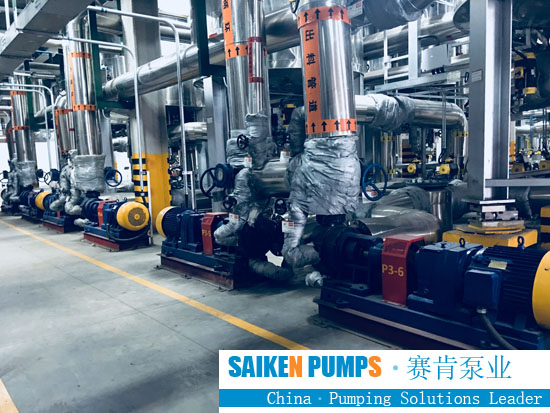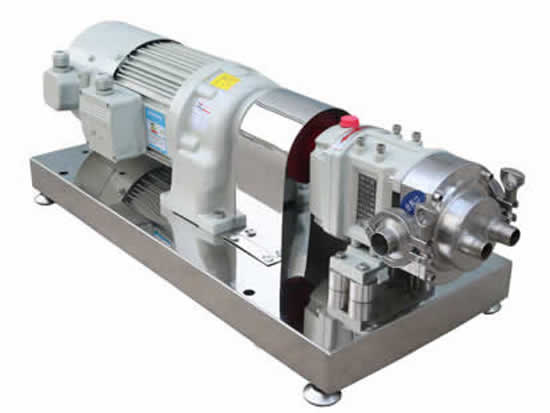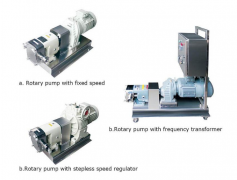High viscosity pumps are often used in the long-term continuous work of the lubrication system of large mechanical equipment. Due to the independent lubrication of the pump bearings, the SS high viscosity pumps have good adaptability to some special industrial occasions and are suitable for conveying various light and volatile Liquid to heavy, viscous liquid, or even semi-solid liquid. High viscosity gear oil pumps are widely used in petroleum, chemical, grease, paint and other industries. Moreover, the high-viscosity pump is also suitable for conveying high-viscosity media such as soap horn, silicone oil, rosin, paint, etc. It is widely used. Seiken pump industry introduces in detail the operation process and common types of high-viscosity pumps, and hopes to help you understand the product of high-viscosity pumps.
The drive gear of high viscosity pump with internal teeth drives the inner rotor to rotate in the same direction in the fully enclosed pump body. The pump body and the crescent plate of the front cover separate the suction port and the discharge port. When rotating, a negative pressure is formed at the suction port, the liquid is sucked, and the liquid is brought to the discharge port, and the pump body is discharged under pressure, and the liquid is completed. The pump head, pump housing, and sealed cavity can be equipped with thermal insulation jackets. According to the actual needs, select the location that needs to be kept warm. The jacket and the pump body are cast into one body, and the heat insulation effect is good, which can avoid various problems caused by the welding jacket. When heating is needed: thermal insulation can be carried out by passing various heat media such as hot steam, thermal oil, etc. into the jacket cavity. When cooling is needed, the constant temperature of the pump body can be maintained by various cooling liquids. Adjustable gap: The pump can adjust the gear gap without disassembling the pump according to the needs of viscosity to meet the process requirements of the pump under different viscosity. The big advantage of the integral bearing box is that only the bearing box can be turned to adjust the gap. The operation is simple, without disassembling any parts of the pump. The pump has a wide adaptability range for viscosity, and has the characteristics of high efficiency, low speed, strong self-priming ability, smooth operation and convenient operation.
The high-viscosity pump has an internal gear drive gear (outer rotor) that drives the inner rotor to rotate in the same direction in the fully enclosed pump body. The pump body and the crescent plate of the front cover separate the suction port and the discharge port. When rotating, a negative pressure is formed at the suction port, the liquid is sucked, the rotor takes the liquid to the discharge port, and the pump body is discharged under pressure, and the liquid is completed. high viscosity gear oil pump is mainly composed of inner and outer rotor, shaft, pump body, front cover, seal, bearing, etc. There are two forms of sealing: mechanical seal and packing seal (special requirements, magnetic drive, zero leakage structure can be selected). For medium with high temperature, high viscosity and strong corrosivity, packing seal is selected.
The gears of high-viscosity pumps commonly have straight teeth, helical teeth, herringbone teeth, and spiral teeth. The tooth profiles are mainly involute and arc. Usually small gear pumps use involute spur gears, high temperature gear pumps often use variable gears, and melt pumps that transport high-viscosity, high-pressure polymer melts mostly use involute helical gears. The gear and the shaft are made in one body, and its rigidity and reliability are higher than that of the gear pump manufactured separately from the gear and the shaft. The gears of foreign low-pressure gear pumps often adopt a square structure, that is, the tooth width of the gear is equal to the diameter of the addendum circle. The tooth width of the SS high viscosity gear oil pump used in high-pressure occasions is smaller than the diameter of the addendum circle. This is to reduce the radial pressure area of the gear and reduce the load of the gear and bearing. The inner diameter of the oil suction pipe of the high viscosity pump should be large enough, and avoid narrow channels or sharp bends, reduce elbows, remove unnecessary valves and accessories, reduce the installation height of the pump as much as possible, shorten the length of the oil suction pipe to reduce pressure loss . The sealing of pipe joints and other components should be good to prevent air intrusion and thus control the occurrence of cavitation and cavitation. Check valve and valve Install a check valve on the output line of the gear pump. In this way, when the pump and the output pipeline are repaired, the liquid in the system will not reverse. When the gear pump is stopped with a load, it can also prevent the pump from reversing and generate a partial vacuum in the output pipe of the high-viscosity pump. It should be noted that the outlet check valve cannot be reversed or stuck. The outlet pipe of the high-viscosity pump should also be provided with a protective device such as a valve, so that once the outlet channel of the pump is blocked, the valve can be opened to relieve the pressure. The valve can be cast integrally with the pump body or pump cover or can be assembled separately. For high-viscosity pumps that require forward and reverse rotation, valves are required on the inlet and outlet pipes.




